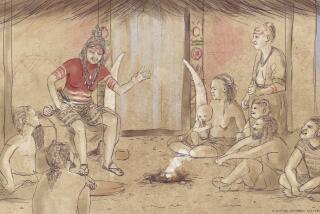Surprise! Ancient European had dark skin and blue eyes, DNA reveals
- Share via
Blue-eyed people have been living in Europe for at least 7,000 years, scientists have discovered.
A man who lived on the Iberian peninsula before Europeans became farmers probably had blue eyes but dark hair and skin, according to scientists who have sequenced his DNA. This surprising combination of eye, hair and skin coloring may have not have been unusual during his lifetime, but it is no longer seen among modern Europeans, the team reported Sunday in the journal Nature. (To see how scientists figured out what he might have looked like, click through the photo gallery above.)
The man, a Neolithic hunter-gatherer known to scientists as La Braña 1, is of great interest to scientists because he offers a snapshot of what was in Europeans’ DNA before agriculture spread through the continent. Experts have theorized that certain genetic traits spread quickly among humans after they adopted the farming lifestyle. La Braña 1 shows that at least some of their predictions were correct.
The man’s skeleton, along with that of a male companion, was discovered in 2006 in a cave in what is now northeastern Spain. The site, known as La Braña-Arintero, sits about 5,000 feet above sea level, and the cave provided a cold, refrigerator-like environment that preserved his DNA.
In the lab, scientists were able to extract enough DNA from a single tooth to reconstruct La Braña 1’s entire genome. They compared it to the DNA of other ancient Europeans (including Otzi, the 5,300-year-old mummy found in a Alpine glacier) and determined that he was a closer match with hunter-gatherers than with farmers.
Two specific genes — one for digesting lactose (the sugar found in milk) and another for digesting starch — offered further evidence that La Braña 1 was not a farmer. New versions of both of these genes spread rapidly among Europeans after agriculture took hold and people began milking their livestock and growing crops. And in both cases, La Braña 1 had an older version of these genes.
Scientists also believe that many of the immune system genes that are common today arose after the rise of agriculture prompted people to live in larger communities, making it easier for diseases to spread. But La Braña 1 already had the modern version of some of these genes, even though farming was still a ways off, the team reported.
When it came to genes that would influence La Braña 1’s appearance, the researchers found that their 7,000-year-old subject had versions of two skin pigment genes that are either very rare or nonexistent among Europeans today. Then they looked at other places in the genome that influence pigmentation and found a mix of ancient and modern gene variants. Taken together, La Braña 1’s DNA “is likely to have resulted in dark skin pigmentation and dark or brown hair,” they wrote.
However, his DNA indicates that his eyes were most likely blue, the scientists found. This suggests that gene variants for light-colored eyes and skin did not spread together, they wrote, adding that La Braña 1’s combination “of dark skin and non-brown eyes is unique and no longer present in contemporary European populations.” Today, a blue-eyed person would typically have fair skin.
To get some idea of whether La Braña 1’s coloring was unusual for his day, the researchers will try to sequence the DNA of his companion, who has been dubbed La Braña 2.
If you wonder about the origin of blue eyes, you like the things I write about. Follow me on Twitter and “like” Los Angeles Times Science & Health on Facebook.







